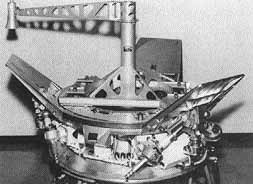
Guidance and Control - Review
Beginning with a report on the ASTP docking targets, Legostayev indicated that the primary target had been mounted on Soyuz and its proper alignment had been verified by Soviet and American specialists during the joint preparations at Baykonur during May. These checkout procedures involved the use of an American-designed fixture mounted on the face of the Soviet docking gear. A contingency target made from three fixed metal plates was also installed on Soyuz, in case the folded primary target failed to erect. In either event, the Apollo commander would have a target on which to sight during the final phase of docking.13 After discussing the orientation lights and the optical tracking hardware, Legostayev turned to the subject of control systems.
The Soviet Working Group 2 chairman noted that extensive studies had been made of the control system from operational and safety standpoints.

[293] The joint team had agreed to two major limitations on the use of the Apollo control system. First, to prevent undue stress from being placed on the Soyuz solar panels, the American agreed to use only two of the four roll jets to rotate the spacecraft during the docked phase of the flight. The second agreed restriction had to do with shutting down the Apollo forward-firing reaction control system (RCS) engines. As agreed during the final meeting in Houston, to protect Soyuz from, the RCS plume, the forward-firing engines would be shut off within 2 seconds after docking system capture. No forward firing would be allowed during the docked part of the flight operations.14
The basic safety of the Apollo and Soyuz propulsion and control systems was documented in reports on each spacecraft, which provided a functional description of those systems and of how they operated. The Soviet and American specialists concluded that the control and propulsion systems of both spacecraft operated in a non-hazardous manner and posed no dangers to the crews during docked operations. Finally, Legostayev told the FRR Board that there were no outstanding issues; from Group 2's point of view all was in readiness for the flight.15 After a few quick questions from John Yardley and Academician Petrov, the FRR attendees adjourned for lunch.
13. Ibid., p. WG-2-2. Results of the docking target verification tests were documented in "ASTP, Results of Verification Tests of Alinement Soyuz Docking Target," IED 50203,20 May 1975.
14. "Apollo Soyuz Test Project, Flight Readiness Review, May 1975," 25 May 1975, pp. WG-2-12 to WG-2-20.
15. Ibid., p. WG-2-21.
The results of the safety assessments were presented in two
documents: "ASTP Safety Assessment Report for Apollo Propulsion and
Control Systems," ASTP 20 102, 3 May 1974, and "ASTP Safety
Assessment Report for Soyuz Propulsion and Control Systems," ASTP 20
202.1, 1 May 1975. Soviet comments on guidance and control are
contained in V. P. Legostayev, "Korabli idut na sblizhenie"
[Spacecraft are approaching each other], in Soyuz i Apollon, pp.
100-115. The author emphasizes the superior automatic (or
ground-controlled) guidance systems of the Soyuz and the changes that
the Soviets had to make in their spacecraft to accommodate the Apollo
systems and configuration incompatibilities.
Next